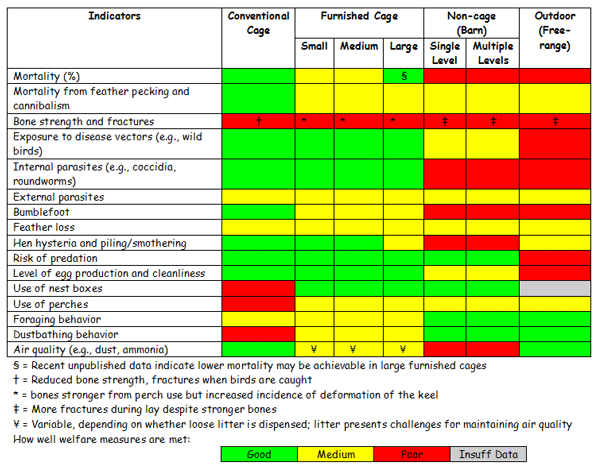



Being sustainable doesn’t equate to a free pass on animal welfare
Good animal-welfare credentials are in the eye of the beholder. Some consumers are willing to pay more for products from companies with reputations that align with their beliefs.The concept of animal welfare is shaped, in part, by the ethics of what constitutes an animal’s quality of life. And, strongly influenced by animal-welfare activists, the consumer is the primary stakeholder driving change in how livestock and poultry are raised in the United States.
Sustainability in context
Sustainability is defined as “the ability to be maintained at a certain rate or level” but today the term is used in reference to the capacity for humans to make changes that do not negatively impact the environment. In other words, meeting today’s needs without compromising the ability of future generations to meet their needs. In order to make their businesses sustainable, successful corporations must be committed to being good stewards of the environment and of the social landscapes in which they operate. Animal welfare represents an important stewardship anchor in the social landscape of the poultry industry. Animal-welfare issues are often associated with sustainability because improvements in both are viewed by many as good, progressive practice. For this reason, any improvement in animal welfare is often also seen as an improvement in the sustainability of production, or as evidence of a reduced environmental impact. However, the relationships between poultry production, poultry welfare and the impact of poultry farming on the environment are complex and difficult to balance.
Environmental stewardship is not animal welfare stewardship
Environmental stewardship, animal welfare and corporate sustainability commitments may not always align. Ultimately, consumer preferences and affordability will shape the evolution of the poultry industry’s commitments to sustainability and animal welfare. However, products that are produced more sustainably in terms of their carbon footprint and environmental impact might establish a positive reputation with consumers without a focus necessarily having been placed on animal welfare.
Animal welfare is essential to the sustainability of the poultry industry, though, because healthy animals provide consumers with a healthy product. Independent of consumer demands, it is the corporate responsibility of the poultry industry to assure its birds are raised according to high welfare standards.
Housing
The laying-hen sector offers a cautionary tale about hasty decisions when it comes to animal welfare. Battery-cage systems have been banned since 2012 in Europe and are currently banned in two states in the US: California and Massachusetts. While cage-free systems provide the birds space to express their full range of natural behaviours, some housing designs can decrease welfare. One of the main hazards in cage-free laying hens systems is the potential for damage to the birds’ keel bones. The keel bone provides the laying hen with assistance in respiration and is important in behavioral expressions, such as wing flapping; damage to the keel bone also inflicts pain on the bird. Laying hens’ keel bones are particularly vulnerable because, compared to broilers, layers’ low muscle mass means less of the keel bone is covered by breast muscle (Hardin et al., 2019). In some cage-free designs for laying hens, keel bone damage can occur when birds fall or collide with other hens while navigating the housing system; this can especially pose a problem in aviaries (Stratmann et al., 2015). The incidence rate of keel-bone fractures in laying hens can be up to 85 percent, and these fractures can be extremely painful to the birds (Casey-Trott and Widowski, 2016). While much progress has been made in the past few years, there is a need for more research to identify the most suitable cage-free systems for laying hens.

Enriched-colony (furnished-cage) systems and outdoor (pasture) systems are alternative laying hen housing systems. While conventional cage systems do not have enrichments such as nest boxes, perches and scratch pads, they do allow for better management of individual hen health. On the other hand, cage-free and outdoor systems may have a negative impact on welfare by increasing the incidence of bumblefoot, endo- and ecotoparasites and mortality. The advantages and disadvantages of conventional-cage, furnished-cage, non-cage and outdoor systems on key laying-hen welfare indicators can be seen in a figure from the American Veterinary Medical Association (AVMA, Figure 1).
Organic production
Organic poultry production is often grouped with sustainability, which may lead consumers to believe that animals raised organically have had an acceptable amount of attention devoted to their welfare. While many organic poultry systems do maintain high welfare standards, maintaining good health and welfare on organic poultry farms can be challenging. This means that that husbandry, or knowledge and technical skills, is crucial for managing welfare issues. The three major challenges for organic poultry production have been identified as: 1) the management of birds in outdoor systems; 2) the limited use of conventional preventative medication in vaccination and disease treatment; and 3) the quality and availability of organic feed (Van De Weerd, 2009). Further research and accessible information is needed to establish the best management practices in organic poultry systems.
Enrichments
Environmental enrichments are increasingly a feature of broiler farms in the US. An enrichment is any stimuli or activity that encourages birds to display a wider range of natural behaviours and improves welfare. Most enrichments on broiler farms today are structural, and aim to promote activity. However, many structural enrichments are difficult to keep clean, may harbour pathogens and require additional labour during cleanout. Also, there are other forms of enrichment that may stimulate positive effects on broilers, such as sensory (eg visual or olfactory) and foraging (food-related) enrichments. More research is needed to identify novel enrichments that are the best option for both the birds and the producer.
The more animal-welfare standards that can be scientifically validated as having tangible benefits for poultry welfare, and the more widely these standards can be applied, the healthier the US poultry industry will be – for both its birds and its consumers.
References
American Veterinary Medical Association (AVMA). AVMA Issues – A Comparison of cage and non-cage systems for sousing laying hens. Accessed 19 November 2019 at https://www.avma.org/KB/Resources/Reference/AnimalWelfare/Pages/AVMA-issues-A-Comparison-of-Cage-and-Non-Cage-Systems-for-Housing-Laying-Hens.aspx
Casey-Trott, T. M. and T. M. Widowski. 2016. Behavioral differences of laying hens with fractured keel bones within furnished cages. Frontiers in Veterinary Science. 42: 1-8.
Hardin, E., F.L.S. Castro, and W. K. Kim. 2019. Keel bone injury in laying hens: the prevalence of injuries in relation to different housing systems, implications, and potential solutions. World’s Poultry Science. 2019. 75:285-292.
Laywel. 2006. Welfare implications of changes in production systems for laying hens. Accessed 19 November, 2019 at https://www.laywel.eu/web/pdf/deliverable%2071%20welfare%20assessment.pdf. .
Stratmann, A., E. K. F. Froehlich, S., S.G. Gebhardt-Henrich,, A. Harlander-Matauschek, H. Wurbel, and M. J. Toscano. 2015. Modification of aviary design reduces incidence of falls, collisions and keel bone damage in laying hens. Applied Animal Behaviour Science. 165:112-123.
Van De Weerd, H. A., R. Keatinge, and S. Roderick. 2009. A review of key health-related welfare issues in organic poultry production. World’s Poultry Science Journal. 65:649-684.
| References | ||||
|---|---|---|---|---|








